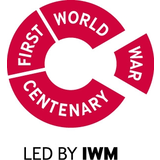Missing and wounded service people
During the First World War
The search for missing soldiers
During the war, many families lost contact with their loved ones. In February 1915, at the request of Lord Robert Cecil, the London Branch of the Red Cross appointed Voluntary Aid Detachment (VAD) members to make enquiries at London hospitals for missing soldiers. No agency with this role existed, so the Red Cross added it to its many other activities.
Members selected by the county secretary visited over 100 London hospitals (including the large military hospitals). For some time, members performed this duty in Middlesex, now mostly part of Greater London.
They were provided with lists of officers and men to enquire about, and they sent their reports directly to the Red Cross headquarters. Later this service was taken over by headquarters, who appointed their own hospital visitor.
There were offices in the UK and branches in Paris, Boulogne, Rouen, Malta, Alexandria, and Salonika.
Work at home
Offices to deal with enquiries for the missing were established by the British Red Cross in Paris, Boulogne and London in the early stages of the war. An office was set up in London before the end of 1914.
It began on a small scale at 83 Pall Mall. Then the London office of the wounded and missing department moved to 20 Arlington Street (lent by Lord Salisbury) in April 1915 with a staff of about 20 voluntary workers, plus typists. This became the clearing house for all enquiries received from the public and for all reports collected by the searchers in hospitals at home and abroad.
The War Office largely regulated the scope of the work from the beginning. Facilities were given to the wounded and missing department for visiting the hospitals and consulting the War Office records, but it was not officially recognised until July 1915. It was then declared as the only organisation permitted to make such enquiries for the missing. The work continued in close liaison with the casualty department of the War Office.
All incoming enquiries were registered in the office and were included in the printed monthly enquiry list. This was distributed to all searchers and the searchers’ reports, as they were received, were communicated to the enquirers.
The department continued to grow and moved to Norfolk House, St James Square in July 1915 and then to 18 Carlton House Terrace in November 1915, lent by Lord Astor. It remained here until the end of the war. Sir Louis Mallet was the director of the department from April 1915 to September 1916 and the Earl of Lucan from September 1916 to the close of work in March 1919.
In October 1916, the section of the department which dealt with prisoners of war was removed to form part of the newly constituted Central Prisoners of War Committee. From that time onwards, all matters referring to prisoners of war were handed over to the committee.
The search for hospitals at home started in 1915 and was gradually developed all over the country. The different districts were placed under the charge of a head searcher. That person (usually a local volunteer) was responsible for seeing that the first-line hospitals, which were those receiving the wounded directly from France, were searched. Every new draft of wounded men was questioned about the names on the missing person list.
In July 1916, the department started to make enquiries for all the missing, whether or not friends or relatives had made a special application. It was judged best to begin enquiring for every man as soon as he was reported missing. The War Office supplied the department with an annotated copy of the daily communiqué of casualties. This gave the essential search details of the missing man’s battalion and company, with the date of the casualty. This information was omitted from the published casualty lists.
The wounded and missing department included the names of all these casualties in their enquiry list. Therefore, they often had information to hand when the family of a missing man made an enquiry. When the War Office let the next-of-kin know about a casualty, they automatically referred them to the Red Cross for further information.
Regular searches in the base hospitals and army rest camps abroad and hospitals at home (about 1,200 searchers were employed in the UK) led to a very wide circulation for the monthly enquiry list. After the armistice, searching was carried out with very good results at the various reception camps in France and England, to which repatriated prisoners of war were first sent.
Another section of the office checked the periodical lists received directly from Germany through the Frankfurt Red Cross. The lists showed people reported as prisoners of war, and their names were then removed by the department from the next enquiry list. All enquiries relating to men in the forces in Italy and the East were dealt with in a separate section, as were all enquiries for officers in France.
It was soon decided that official forms and methods should be discarded when writing to relatives waiting for information about ‘the missing’. This was so that each enquirer felt that a personal interest was taken in his or her case. During the war, the department received 342,248 enquiries.
Work in France
In August 1914, two or three Red Cross workers began to collect lists of wounded people in French hospitals and to answer enquiries received at the Red Cross headquarters in Paris. Lord Robert Cecil also visited the Villers Cotterets district to find and mark graves.
Arrangements were made for visitors to collect daily lists of admissions to hospitals in the Paris area. Lists of admissions were also received from the French government. The casualty list from the Times was put on a card index and all enquiries were checked against it. Letters addressed to soldiers picked up on the Marne battlefields were brought to the office and they undertook to return them to the writers.
On 20 October the office moved from a room in a hotel into rooms at No 23 Rue de la Paix. The army agents occupied the same building and were also receiving enquiries. A joint list of names was telegraphed daily to the deputy adjutant general, 3rd Echelon at Nantes, asking whether a casualty had been reported. The 3rd Echelon was the branch of the General Headquarters in France which dealt with records, casualties and reinforcements.
The first list of British prisoners, containing 128 names, was received on 28 November 1914 from the United States Consul-General in Paris. Later these lists came from the Geneva Red Cross, twice a week, as they were received from Germany. Information was sent direct to the relatives, often reaching them ten days before it was received from the War Office.
In November 1914, the editor of the Evening News advertised every day in his paper, with long lists of names titled ‘Where are these men?’. These lists were brought to the Paris office to obtain information.
Another branch of work consisted of tracing graves. An additional Red Cross unit started operations in the north and communicated with the Boulogne office. Towards the end of March 1915, the whole of the graves work was taken over by the War Office.
A ‘watching list’ was also used in all offices in France. Admission to hospitals in all areas could be checked against it and relatives of sick and wounded officers who chose to register their name could be informed immediately of the location and condition of the patient. There were over 1,500 names on the list.
The Paris office ceased to exist on 5 June 1915 as the hospitals in the area had closed.
An office opened in Boulogne on 1 November 1914 and was transferred to the Hotel Christol on 30 May 1915. The office began with three searchers, which grew to 12 by October 1917.
The military authorities in hospitals and camps gave assistance where they could. For example, the deputy director of medical services made telephone enquiries from casualty clearing stations and hospitals with which the department could not communicate. The office closed on 22 February 1919.
Work in Malta
The regular staff of searchers sought news of missing men and visited Malta’s hospitals daily. This was to ensure that information was up-to-date and reliable. An arrangement was made to take photographs of the graves of soldiers who died in hospital and were buried in Malta. These photographs were sent to their relatives. The number of local enquiries during the First World War totalled 4,461.
Work in Egypt and Palestine
The need for an enquiry service in Egypt and Palestine was never greater than in June 1915. The department was initially set up in Alexandria and Cairo. They took over the responsibility of dealing with the enormous number of enquiries reaching the office. With help from the army and several local patrons, a large majority of the officers were visited and interviewed for information in the auxiliary hospitals. During the four years that the department was open, 54,706 reports on sick and wounded men were dispatched.
Salonika and Corfu
Work here was carried out with great difficulty as the hospitals in the region were scattered, with inadequate means of communication. In 1918 the scope of the work by the department increased immensely. Over 6,000 patients were interviewed, and 3,000 cables were sent to Britain.
Sources
- Reports by the Joint War Committee and the Joint War Finance Committee of the British Red Cross Society and the Order of St John of Jerusalem in England on voluntary aid rendered to the sick and wounded at home and abroad and to British prisoners of war 1914–1919
- The Red Cross: The Official Journal of the British Red Cross Society, Vol. 2 No. 7
- Oliver, Beryl (1966) The British Red Cross in Action; London; Faber and Faber Limited.
We offer this information on the First World War for free. If you can, please donate now to help cover our costs.
You may also be interested in:
VAD casualties during WW1
Many brave Red Cross volunteers gave their lives helping wounded service men and women.
Volunteers during WW1
90,000 ordinary men and women volunteered with the Red Cross during WW1 in hospitals, driving ambulances, and more.
Auxiliary hospitals
British Red Cross hospitals proved vital in WW1, treating hundreds.


